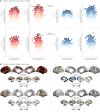Network-based atrophy modeling in the common epilepsies: A worldwide ENIGMA study
- PMID: 33208365
- PMCID: PMC7673818
- DOI: 10.1126/sciadv.abc6457
Network-based atrophy modeling in the common epilepsies: A worldwide ENIGMA study
Abstract
Epilepsy is increasingly conceptualized as a network disorder. In this cross-sectional mega-analysis, we integrated neuroimaging and connectome analysis to identify network associations with atrophy patterns in 1021 adults with epilepsy compared to 1564 healthy controls from 19 international sites. In temporal lobe epilepsy, areas of atrophy colocalized with highly interconnected cortical hub regions, whereas idiopathic generalized epilepsy showed preferential subcortical hub involvement. These morphological abnormalities were anchored to the connectivity profiles of distinct disease epicenters, pointing to temporo-limbic cortices in temporal lobe epilepsy and fronto-central cortices in idiopathic generalized epilepsy. Negative effects of age on atrophy further revealed a strong influence of connectome architecture in temporal lobe, but not idiopathic generalized, epilepsy. Our findings were reproduced across individual sites and single patients and were robust across different analytical methods. Through worldwide collaboration in ENIGMA-Epilepsy, we provided deeper insights into the macroscale features that shape the pathophysiology of common epilepsies.
Copyright © 2020 The Authors, some rights reserved; exclusive licensee American Association for the Advancement of Science. No claim to original U.S. Government Works. Distributed under a Creative Commons Attribution NonCommercial License 4.0 (CC BY-NC).
Figures





References
-
- Avena-Koenigsberger A., Misic B., Sporns O., Communication dynamics in complex brain networks. Nat. Rev. Neurosci. 19, 17–33 (2017). - PubMed
-
- Fornito A., Zalesky A., Breakspear M., The connectomics of brain disorders. Nat. Rev. Neurosci. 16, 159–172 (2015). - PubMed
-
- Richardson M. P., Large scale brain models of epilepsy: Dynamics meets connectomics. J. Neurol. Neurosurg. Psychiatry 83, 1238–1248 (2012). - PubMed
-
- Bernhardt B. C., Bernasconi A., Liu M., Hong S.-J., Caldairou B., Goubran M., Guiot M. C., Hall J., Bernasconi N., The spectrum of structural and functional imaging abnormalities in temporal lobe epilepsy. Ann. Neurol. 80, 142–153 (2016). - PubMed
Publication types
Grants and funding
- P41 EB015922/EB/NIBIB NIH HHS/United States
- R21 NS107739/NS/NINDS NIH HHS/United States
- R01 MH118514/MH/NIMH NIH HHS/United States
- R01 MH116147/MH/NIMH NIH HHS/United States
- U54 EB020403/EB/NIBIB NIH HHS/United States
- MR/K013998/1/MRC_/Medical Research Council/United Kingdom
- R01 NS110347/NS/NINDS NIH HHS/United States
- R01 NS122827/NS/NINDS NIH HHS/United States
- R01 NS065838/NS/NINDS NIH HHS/United States
- U54 MH091657/MH/NIMH NIH HHS/United States
- MR/K023152/1/MRC_/Medical Research Council/United Kingdom
- R56 AG058854/AG/NIA NIH HHS/United States

